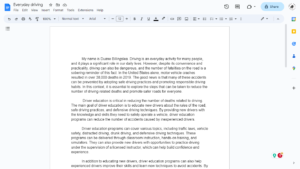
Name: Daz Billingslea
From: Corona , California
Votes: 0
Everyday driving
Driving is an everyday activity for many people, and it plays a significant role in our daily lives. However, despite its convenience and practicality, driving can also be dangerous, and the number of fatalities on the road is a sobering reminder of this fact. In the United States alone, motor vehicle crashes resulted in over 38,000 deaths in 2019. The good news is that many of these accidents can be prevented by adopting safe driving practices and promoting responsible driving habits. In this context, it is essential to explore the steps that can be taken to reduce the number of driving-related deaths and promote safer roads for everyone.
Driver education is critical in reducing the number of deaths related to driving. The main goal of driver education is to educate new drivers about the rules of the road, safe driving practices, and defensive driving techniques. By providing new drivers with the knowledge and skills they need to safely operate a vehicle, driver education programs can reduce the number of accidents caused by inexperienced drivers.
Driver education programs can cover various topics, including traffic laws, vehicle safety, distracted driving, drunk driving, and defensive driving techniques. These programs can be delivered through classroom instruction, hands-on training, and simulators. They can also provide new drivers with opportunities to practice driving under the supervision of a licensed instructor, which can help build confidence and experience.
In addition to educating new drivers, driver education programs can also help experienced drivers improve their skills and learn new techniques to avoid accidents. By promoting ongoing education and training, driver education can help drivers stay up-to-date with the latest safety measures and technology.
However, driver education alone is not enough to reduce the number of deaths related to driving. A comprehensive approach that includes education, law enforcement, infrastructure improvements, technology, public awareness, and policy changes is necessary.
Law enforcement agencies can play a critical role in reducing the number of accidents and fatalities on the road. By enforcing traffic laws and implementing measures such as sobriety checkpoints, speed cameras, and red-light cameras, law enforcement can deter dangerous driving behavior. Tougher penalties for drivers who engage in reckless driving, DUIs, or distracted driving can also help reduce accidents.
Infrastructure improvements can help reduce accidents and fatalities as well. Safer intersections, guardrails, and collision avoidance systems can be installed. The government can also consider lowering speed limits in high-risk areas and increasing the number of traffic signals.
Technological advancements in vehicle safety can also help prevent accidents. Advanced driver assistance systems (ADAS) like lane departure warning, automatic emergency braking, and blind-spot monitoring can help drivers avoid crashes.
Increasing public awareness campaigns and education programs can also make a significant impact. These campaigns can focus on the dangers of distracted driving, drunk driving, and other risky driving behaviors. They can also educate the public about the importance of following traffic laws, using seat belts, and avoiding dangerous driving practices.
To help others become safer on the road, one can promote responsible driving habits and encourage others to obey traffic laws and speed limits. It is also crucial to lead by example and to speak up when witnessing dangerous driving behavior. By promoting safer driving habits.
In addition to these broader measures, drivers themselves can take steps to become safer on the road and help others become safer. To be a better and safer driver, one can take several steps, including obeying traffic laws and speed limits, avoiding distractions such as cell phones, and practicing defensive driving techniques. It is also essential to maintain one’s vehicle, including regular maintenance and tire checks. Furthermore, one can participate in driver education programs to enhance their knowledge and skills on the road.
In conclusion, safe driving practices are essential to prevent accidents and fatalities on the road. Policies such as graduated driver licensing and increasing penalties for dangerous driving behaviors can be implemented. Graduated driver licensing programs can help new drivers gain experience and confidence under supervision. Increasing penalties for dangerous driving behaviors can act as a deterrent to reckless driving. By following traffic laws, avoiding distractions, and practicing defensive driving, we can ensure our safety and the safety of others on the road. Additionally, promoting responsible driving habits and encouraging others to do the same can make a significant impact in reducing risky driving behavior. Safe driving is not just about protecting yourself but also about protecting everyone else on the road. By taking steps to become better and safer driver, we can all play a role in creating safer roads for everyone.